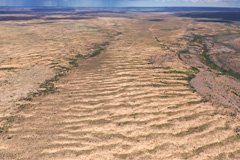Dr. Stephan Getzin | Scientist | Ecologist
Phenotypic changes and a population-level response to water stress
Plants in arid environments often form spatially periodic vegetation patterns in order to respond to water stress. This patterned type of a population-level response to resource stress happens mainly in species-poor communities where only very few herbaceous or woody species dominate. The simple structure of the plant community thus allows for the emergence of strongly geometric patterns, composed of plants and bare soil, because there are no other niche-adapted species that would occupy the space. Usually, there is a pattern sequence between the two stable states of uniform vegetation cover under higher precipitation regimes on the one hand and bare soil at very low mean annual precipitation on the other. In-between these two stable states, so-called Turing patterns emerge which range from gapped vegetation under higher rainfall to vegetation stripes and labyrinths, and finally vegetation spots under strongly decreasing rainfall. Along this pattern sequence, the proportion of bare soil per area increases continuously. This sequence of changing patterns is not only theoretically predicted by models, but it is also found in natural vegetation systems such as in Sudan of the Sahel region. Overall, the patterns emerge because there is partial mortality of plant populations, which generally improves ecosystem resilience. Hence, while some plants have to die, the emerging patterns of bare soil are of great benefit to the plant population because the bare-soil areas constitute an extra source of water for the plants.
The formation of fairy circles has been explained with vegetation self-organization for Namibia, where grasses draw water towards them via the uptake-diffusion feedback, as well as for Australia, where overland flow is dominating. So far lacking, however, was an explanation why we can’t observe the sequence of fairy-circle gaps, to stripes, and finally spots along declining precipitation in the Namib Desert. In the Pilbara region of Western Australia, for example, we can observe the coexistence of fairy circles and labyrinths or stripes formed by the same type of grass in one and the same landscape. While self-organized vegetation stripes do also occur in western Namibia such as around Büllsport or near the Zarishoogte Pass, they do not occur in the vicinity of the fairy circles. The question of why not is now answered by the new study of Bennett et al. Phenotypic plasticity: A missing element in the theory of vegetation pattern formation, which appeared in PNAS on December 7th, 2023. This research was conducted over many years in the working group of Prof. Ehud Meron at Ben-Gurion University in Israel, and I contributed myself with several spatial analyses of drone and model images.
The new study shows that a second mechanism to improve ecosystem resilience, namely phenotypic plasticity in individual grass plants, may act in concert with the population-level response to aridity stress. To some extent, grass plants may adapt their root growth to reach deeper soil layers with more moisture, provided they have sufficient time to do so in a suitable rainfall season. In most rainfall seasons, this does not happen within the fairy circles because the water-drawing large edge plants around the gaps take up too much water. As a consequence, the freshly germinated grasses within the circles are strongly weakened and seedlings cannot develop roots longer than 10 cm to reach moister soil layers below the quickly drying topsoil. But under certain rainfall scenarios, the conditions can be more favourable and plants can grow deeper with their roots. This phenotypic change in plants is known as hydrotropism, where roots preferentially initiate and extend into more moist soil volumes by sensing water potential gradients. The study demonstrates that the sequence of patterns, gaps, stripes to spots, which is predicted by the current theory, is indeed reproduced by the model for a zero phenotypic transition rate, meaning for plants that are unable to grow deeper roots (see Figure 1 A-C). However, for nonzero transition rates, other scenarios are possible, as the availability of an additional mechanism to relax water stress, growing deep roots, interferes with spatial patterning. Figure 1 D–F shows such a scenario for fairy-circle patterns along the rainfall gradient and Figure 1 G–I shows empirical images for declining annual rainfall from 120 mm to 27 mm. Besides these large-scale patterns of fairy circles, we were also able to reconstruct the small-scale patterns of individual grasses that grow in-between the fairy circles. Here we used drone images and applied spatial statistics to the grass pattern within a 40 m × 40 m observation window. Similarly, the modelled grasses have been analyzed in the same way, demonstrating that the spatial signature of the real-world grasses and modelled grasses showed a strong agreement in the patterning. This new PNAS study can be seen as an inspiration for future research because it combines for the first time the mechanism of phenotypic plasticity with the population-level response to water stress. Finally, the study emphasizes that these different ways of compensating for water stress, for example as a result of climate change, can improve the resilience of ecosystems if they work together.
Welcome to FAIRY-CIRCLES.info! I am interested in the ecology of drylands, fairy circles, plant rings and all kinds of spatial vegetation and animal patterns, using a whole range of quantitative methods.


